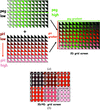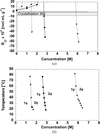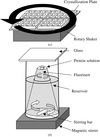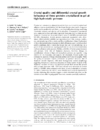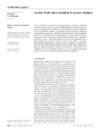issue contents
June 2005 issue
Proceedings of the 10th International Conference on the Crystallization of Biological Macromolecules
Beijing, People's Republic of China, 5-8 June 2004

Cover illustration: ICCBM10
crystallization for structural genomics
Open  access
access
 access
accessThe current workflow for crystallization at the Oxford Protein Production Facility (OPPF) is described.
A fully automated robotic system for the crystallization and observation of macromolecules, HTS-80, has been developed.
Discussion of high-throughput optimization strategies used in the Yeast Structural Genomics Project, with selected successful examples.
HalX, software designed as an `electronic lab book', aims at (i) storage and (ii) easy access and use of all experimental data. Its use should lead to much improved management and tracking of structural genomics experimental data.
The high-throughput crystal structure determination pipeline at Southeast Collaboratory for Structural Genomics, a pilot center of the National Institutes of Health Protein Structure Initiative, is described.
obtaining the first crystals
The Man/Glc-specific lectin from P. angolensis was crystallized in complex with Man(α1-3)ManMe. Competition soaks allowed the replacement of the bound disaccharide by a series of different mono- and oligosaccarides, as well as extraction of the bound sugar and metal ions.
Strictosidine synthase is a central enzyme that participates in the biosynthesis of plant monoterpenoid indole alkaloids. The native enzyme and its complex with the substrate tryptamine were crystallized and analyzed by X-rays.
Crystals of vinorine synthase and selenomethionyl-labelled vinorine synthase have been obtained by a hanging-drop method and were analyzed by X-ray crystallography. Vinorine synthase is the first crystallized enzyme which belongs to the BAHD superfamily.
Crystallization of a suPAR–ATF complex.
Crystallization of an anti-factor IX antibody.
Canavalin is found to crystallize from pH 6.4 to 9.6. Fluorescence anisotropy and light-scattering measurements indicate that the solution is composed of trimers.
This report details a new method to introduce high concentrations of NaCl into crystals of thermolysin. The crystal obtained by this method diffracted X-rays to 2.43 Å and the crystal structure of thermolysin in the presence of 4 M NaCl was solved for the first time.
preparation of complex biomacromolecules
The crystal quality of the large ribosomal subunit was enhanced using active-state ribosomes.
Virus crystals can incorporate a wide range of unusual impurities, not possible for conventional crystals or even most protein crystals, because of the large size of their constituent particles. Examples of several of these unusual impurities are presented here, along with some of the consequences for the crystal lattices.
Interactions leading to crystallization of the integral membrane protein bacteriorhodopsin were investigated. Osmotic second virial coefficients were measured by self-interaction chromatography.
Crystal structures of GGA1-GAE and γ1-ear domains in complex with cognate peptides were determined. Use of peptide-tagged proteins for crystallization of the γ1-ear/peptide complexes improved the diffraction qualities significantly.
A mechanistic model consistent with experimental data is proposed for the pressure-induced ordering of a macromolecular crystal.
Open  access
access
 access
accessPeptides whose conformation is ill defined can be crystallized in complex with proteins where in the lattice they will adopt multiple conformations. The peptide in complex with an anti-HCV monoclonal antibody is most ordered where it has the most space to achieve it own energy minimum.
Open  access
access
 access
accessTryptophans introduced in protein L (PpL) for stopped-flow fluorescence studies make crystal contacts when two different PpL mutants, Y64W and A66W are crystallized bound to an Fab′. The lattice parameters are almost identical in two crystallographic directions, but are significantly different in the third direction, showing that a small displacement of a contact residue is amplified in the lattice.
improving crystal and data qualities
Analytical ultracentrifugation was used to study the crystal growth units in hen egg-white lysozyme pre-crystallization solution.
A solution-stirring technique was used to obtain high-quality ADA complex and ADA native crystals.
Trends were analyzed from two decades of microgravity crystallization history. It was found that dedicated microgravity missions increase the chance of success when compared with those where crystallization took place as a parasitic aspect of the mission.
A dynamic seeding method different from the conventional methods in a non-equilibrium serial micro/macroseeding and its successful use in the optimization of the CutCm protein crystal growth are described.
A simplified screen has been designed based on the efficiency of crystallization conditions from different screens and relevant studies and results of test experiments have shown that it could improve the success rate of crystallization and reduce consumption.
Anaerobic crystallization of ferredoxin II from D. gigas.
Crystallization under pressure and in agarose gel of thaumatin and two lysozymes reveals specific effects that are correlated with alterations of the protein hydration shells.
Minute amounts of protein impurities alter the growth of aspartyl-tRNA synthetase crystals. With the purest enzyme, the best crystals are grown in environments where convection is reduced.
Open  access
access
 access
accessThe assessment of protein crystal perfection with X-rays is reviewed. Several X-ray diffraction physics applications with protein crystals that harness perfection are given. Applications in neutron protein crystallography are then described.
new approaches
A novel ampholyte buffer suitable for crystallization using the ProTeam FFE apparatus has been developed. This buffer is able to generate pH gradients owing to the use of low-molecular-weight electrolytes.
A report of the systematic comparison of crystal structures produced by the nanobiofilm template method and by the classical hanging-drop vapour-diffusion method.
In lysozyme crystal growth induced by a lysozyme thin-film template direct protein transfer appears to occur from the LB film into the crystal being formed, giving a possible explanation for the mechanisms involved in crystal nucleation and growth.
crystal growth physics
Glutaraldehyde cross-linking followed by separation has been used to detect aggregates of chicken egg-white lysozyme (CEWL) in supersaturated solutions
Metastable states such as liquid–liquid phase separation, aggregation and gelation can affect protein crystallization. Mixtures of PEG and a large model protein, glucose isomerase, have been studied to characterize the effect of a metastable liquid–liquid phase separation on protein crystallization.
The surface morphology and kinetic properties of rapid growth of EAFP protein crystals are observed by atomic force microscopy. The characteristic pattern related to the rapid growth is discussed.
The van der Waals equation of state for imperfect gases is applied to solutions of macromolecules, especially to explain the fluid–fluid phase transition in protein solutions. Due account is taken of dimerization owing to intermolecular attraction, hard-sphere and electrostatic repulsion, as well as excluded volume effects caused by inert co-solutes.
Physical processes that effect protein crystal growth velocities are discussed. In particular, methods that can be applied to determine the occurrence of kinetic roughening are evaluated.


 journal menu
journal menu











